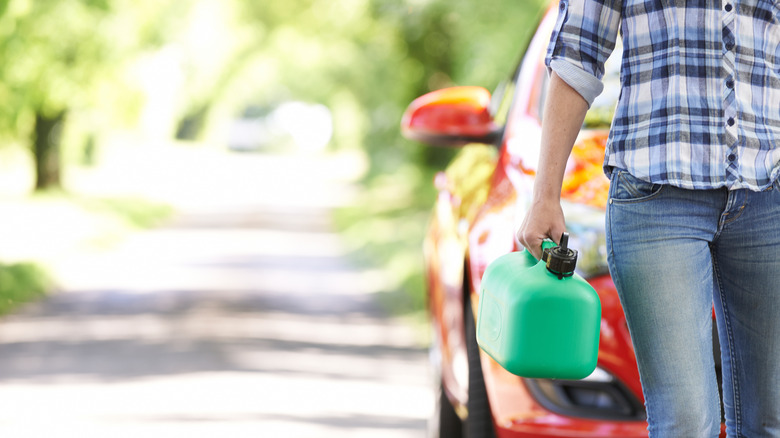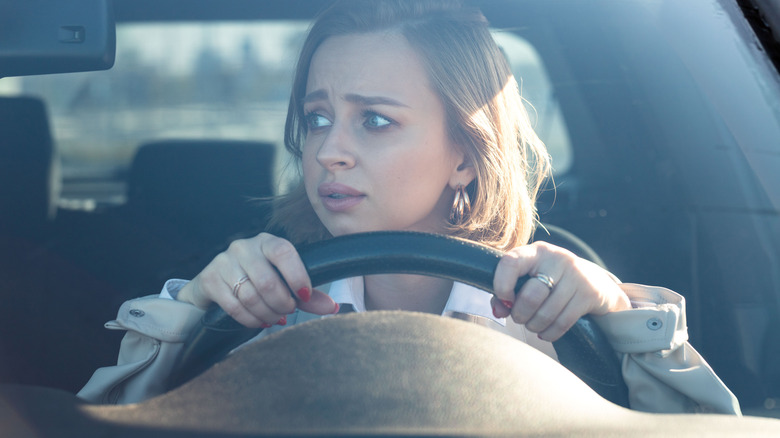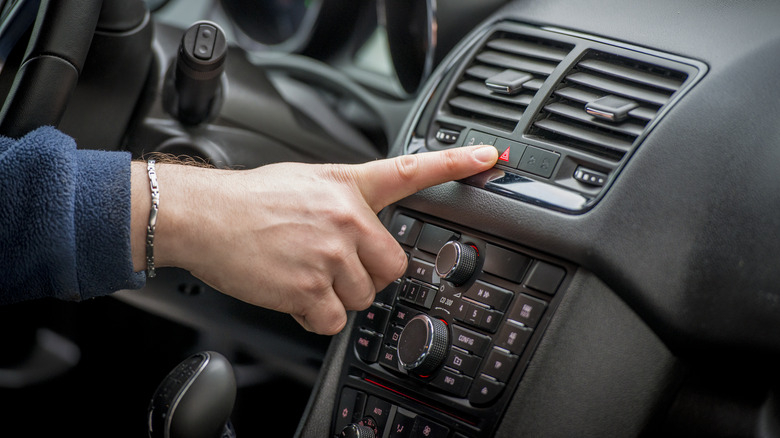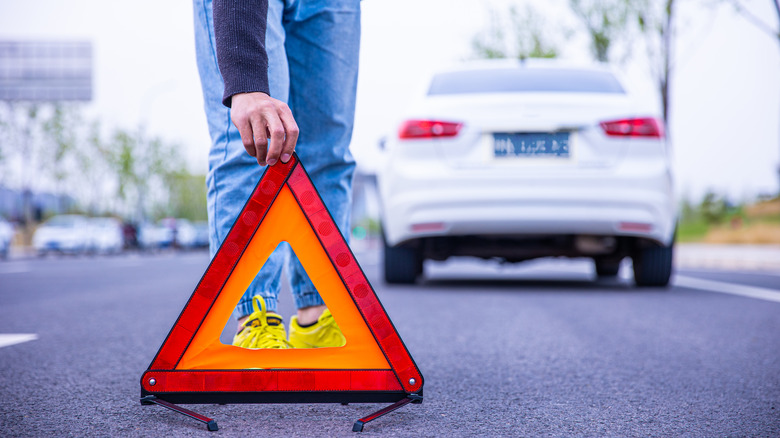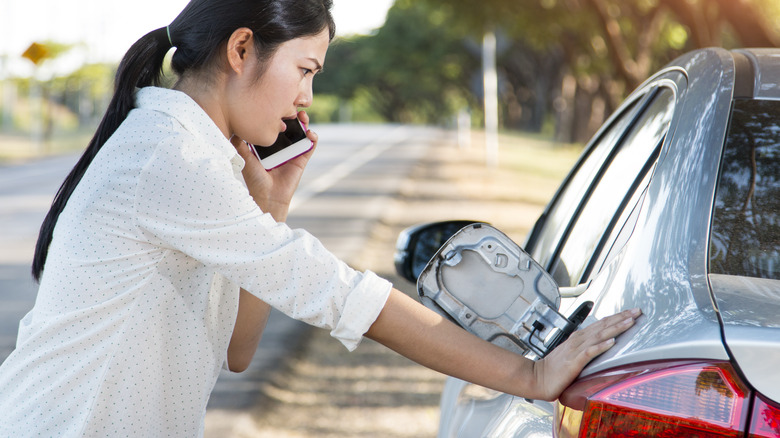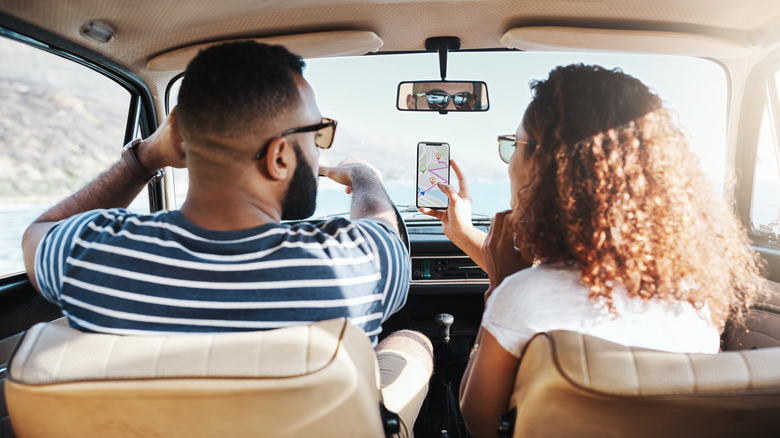The First 4 Things You Should Do When Running Out Of Gas On A Road Trip
When going on a road trip, things don't always unfold as planned. One of the biggest obstacles is running low on gas and not finding a gas station nearby. It can be a stressful situation, but you can handle it. First, don't freak out. By staying calm and collected, you can focus on finding a solution. It's important to note that braking and steering will become more difficult when your car runs out of gas. When you feel this happening, quickly get off the road — especially if it's a busy one. Soon after, your vehicle will stall because there isn't enough fuel to power your engine.
Running out of gas during a road trip is stressful, but it doesn't have to ruin your adventure. By having a plan for a gasless situation, you can turn a fuel-related setback into a mere pit stop on your trip. You don't have to imagine what this looks like; we'll guide you.
Safely pulling over
To ensure your safety and that of other drivers, it's important to act quickly and pull over to the right side of the road. Activate your turn signals to communicate your intention to pull over, giving other drivers ample time to react. If possible, choose a spot with a wide shoulder, designated rest area, or safe parking lot to pull over. If you're on a busy highway, move into the right lane and onto the shoulder, away from traffic.
To minimize the chances of accidents or any other road-related incidents, try to move your vehicle off the road as much as possible. This not only keeps you safe, but it also helps other drivers avoid any potential collisions. Stay alert and aware of your surroundings. Being proactive about safety can make all the difference in these situations, allowing you to move on to the next step effortlessly.
Turn on your hazard lights
After you pull over to the side of the road, it's important to turn on your hazard lights. These lights make your turn signal lamps flash simultaneously, letting other drivers know there's a problem ahead. It also helps make your car more visible to other drivers. To activate your hazard lights, find the button on your dashboard that usually shows a red triangle or two blinking triangles. Press this button, and all turn signal lights will flash at the same time in most vehicles. Check your instrument cluster to confirm that the hazard lights are on.
Promptly turning on your hazard lights makes the roadside safer for you and others, reduces the risk of accidents, and helps manage unexpected situations like running out of gas while on a road trip. It's worth knowing that the hazard lights of some European vehicles activate automatically when they detect a problem; therefore, your car might do all the work in this situation.
Assess the situation
After you turn on your vehicle's hazard lights, take a moment to look around and decide what to do next. If it's safe to do so and have them with you, use emergency triangles or flares to ensure other drivers can see your vehicle. These warning devices are especially helpful in areas where it's hard to see or where people drive fast. The general rule is placing three flares or triangles on the road. The first should be 10 feet behind the side of the car closest to the road, the second 100 feet behind the vehicle, and the third behind the right side 100 feet away on an undivided highway or 300 feet away on a divided road.
If you're trying to decide whether to stay in your vehicle or get out, consider how safe your location is. If you're on a fairly safe stretch of road, staying in your car with your seatbelt buckled is probably best. This will keep you safe and secure while you wait for help. However, if you're in an unsafe location, like a busy highway, and you choose to get out of your vehicle, get out on the side away from traffic to minimize the risk of being struck by a passing car. Move to a designated safety zone like the shoulder or a nearby embankment and stay vigilant to oncoming traffic. Never attempt to cross multiple lanes of traffic on foot.
Call for assistance
Once you have secured your surroundings, the next step is to call for help. If you are a member of a roadside assistance program, call the number provided by your service provider. Make sure to let them know your exact location and explain that you have run out of gas. They will dispatch a service vehicle to your location to assist you. You can call a local tow service if you don't have roadside assistance. When you call, share your location and ask about their services and estimated arrival time. It's important to note that some tow services may not be able to provide fuel, so be sure to ask about their capabilities before they arrive.
Some states offer free roadside assistance; check with the local Department of Public Safety or Department of Transportation to determine if services are available. If you have a trusted friend or family member nearby, call them to bring you fuel or help make further arrangements.
Avoiding empty tanks and more on your road trip
When you're hitting the road for a trip, it's essential to take some steps to avoid any issues that might come up. One of the biggest things to remember is to keep an eye on your fuel gauge and plan stops at gas stations before your tank gets too low. Make sure you know how far your car can go on a full tank, and use helpful tools like Waze and GasBuddy to find nearby gas stations. Even if your tank isn't getting low yet, filling up during breaks is smart, so you're always ready to roll again.
It's also important to prepare your car and pack an emergency kit. Check your car's oil, tire pressure, and brakes to avoid unexpected breakdowns or accidents. Bring a flashlight, first aid supplies, and a spare tire in case of emergencies. Stay alert while driving and take breaks to avoid fatigue during your trip. Enjoy the journey, including the pit stops, as they all add to the adventure.
